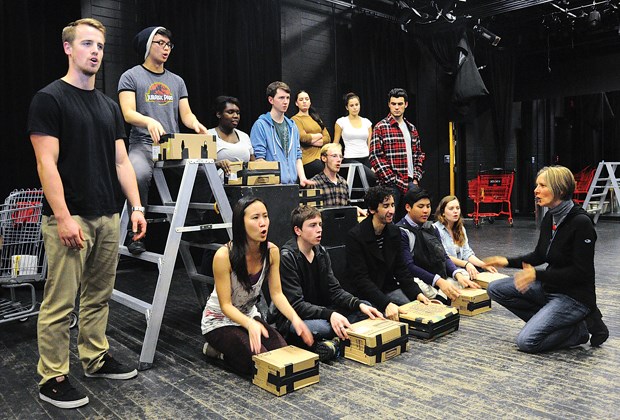The Good Person of Setzuan, Cap Theatre Exit 22 production, The BlueShore at Cap, Nov. 13-15, 19-22 at 8 p.m. and Nov. 16 and 22 at 2 p.m. For more information visit capilanou.ca/blueshorefinancialcentre/14-Good-Person-of-Setzuan/.
Slow down. Red light.
Merge. Wait, wait. .. music.
During September and October, composer Marguerite Witvoet sliced through Vancouver's rainslicked streets astride her scooter, dreaming of the melodies of good and evil and the sounds of the gods.
Witvoet is the composer for Capilano University's production of The Good Person of Setzuan. Bertolt Brecht's play, written mainly during the Second World War, is an examination of the rarity of virtue and the misfortunes that often befall the virtuous.
The play has been adapted by playwright Tony Kushner, best known for penning Angels in America and serving as the scribe behind Steven Spielberg's Lincoln.
Witvoet has worked on productions ranging from Agatha Christie's The Mousetrap to Noel Coward's Hay Fever, but for this most recent project she faced the difficult task of breathing modern music into the seemingly impenetrable themes of the 70-year-old German play.
"Some of the song lyrics, when I first read them, they were a little cryptic to me," Witvoet admits.
But as she delved deeper into Brecht's ideas about men and women and the way a kind heart can be a hindrance in the struggle for survival, she realized the play was perfectly clear.
The next challenge was her schedule. To get the music ready Witvoet needed to write one song each week.
After committing the play's lyrics to memory Witvoet worked on the music during her spare time, which was mainly limited to her commute.
Composing while driving turned out to be quite effective, she reports.
"I think when you're engaged in another task you access a different part of your brain, maybe a more intuitive part of your brain."
Upon arriving at her destination, Witvoet would hop off the scooter and pull out her iPhone to dictate a rhythm or a melody.
Asked if her driving was OK during that stretch, Witvoet replies: "No complaints."
The genesis for the production's music stemmed from a question posed by director Stuart Aikins: What is the vernacular music of Vancouver?
After a little meditation, Witvoet says she realized there was no single musical style that represented Vancouver's cultural patchwork. Accordingly her soundtrack draws inspiration from the Bollywood-style show tunes she hears on car radios as well as blues, reggae, and one song inspired by a YouTube craze.
The play's rhythmic work song started out as a chain gang tune featuring the vocal call and response often used in gospel and soul music.
But as Witvoet searched for the rhythm of the factory, she recalled the crisp rhythms of cup songs, an online trend in which young musicians use plastic cups as percussion.
While the play's musical styles are influenced by the city, the emotion of each song is rooted in the psychology of the play's characters.
In one scene, the play's protagonist, Shen Te, watches as her lover seems to hold each one of her ideals in his hands.
"He basically smashes them to the ground," Witvoet says.
A rock ballad seemed appropriate for that moment, the composer explains.
"It really becomes quite a violent rock number by the end."
After writing the play's music Witvoet needed to hear how her songs sounded in the voices of the actors.
The play features students who are "in some cases learning what it is to sing at the same time as they're learning the song," Witvoet explains.
After getting the music to the singers, Witvoet would make last-minute changes, sometimes building a song around a particular singer's voice.
Witvoet's last task was to create tracks for each of her songs.
"There was not a budget to hire live musicians which I would've loved to have done."
Track by track and instrument by instrument, Witvoet used her keyboard and a music production computer program to build the songs.
"That's the reality these days," Witvoet says.
"Most of the working composers in Vancouver who are doing film scores and television scores are a team of one or two with a big Midi setup and they do it all electronically."



